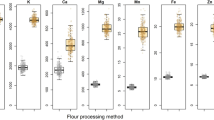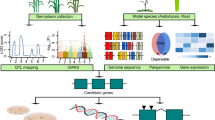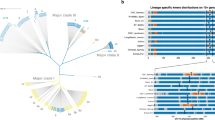Abstract
The high molecular weight (HMW) subunits of wheat glutenin are major determinants of the elastic properties of gluten that allow the use of wheat doughs to make bread, pasta, and a range of other foods. There are both quantitative and qualitative effects of HMW subunits on the quality of the grain, the former being related to differences in the number of expressed HMW subunit genes. We have transformed bread wheat in order to increase the proportions of the HMW subunits and improve the functional properties of the flour. A range of transgene expression levels was obtained with some of the novel subunits present at considerably higher levels than the endogenous subunits. Analysis of T2 seeds expressing transgenes for one or two additional HMW subunits showed stepwise increases in dough elasticity, demonstrating the improvement of the functional properties of wheat by genetic engineering.
This is a preview of subscription content, access via your institution
Access options
Subscribe to this journal
Receive 12 print issues and online access
$209.00 per year
only $17.42 per issue
Buy this article
- Purchase on Springer Link
- Instant access to full article PDF
Prices may be subject to local taxes which are calculated during checkout
Similar content being viewed by others
References
Tatham, A.S., Shewry, P.R., and Belton, P.S. 1990. Structural studies of cereal prolamins, including wheat gluten, pp. 1–78 in Advances in Cereal Science and Technology (Vol. 10). Pomeranz, Y. (ed.) AACC, St. Paul, MN.
Payne, P.I. 1987. Genetics of wheat storage proteins and the effect of allelic variation on breadmaking quality. Annu. Rev. PI. Physiol. 38: 141–153.
Shewry, P.R., Halford, N.G., and Tatham, A.S. 1992. The high molecular weight subunits of wheat glutenin. J. Cereal Sci. 15: 105–120.
Seilmeier, W., Belitz, H.-D., and Wieser, H. 1991. Separation and quantitative determination of high-molecular-weight subunits of glutenin from different wheat varieties and genetic variants of the variety Sicco. Z. Lebensm. Unters. Forsch. 192: 124–129.
Halford, N.G., Field, J.M., Blair, H., Urwin, P., Moore, K., Robert, L., et al. 1992. Analysis of HMW glutenin subunits encoded by chromosome 1A of bread wheat (Triticum aestivum L.) indicates quantitative effects on grain quality. Theor. Appl. Genet. 83: 373–378.
Shewry, P.R., Tatham, A.S., Barro, F., Barcelo, P., and Lazzeri, P. 1995. Biotechnology of breadmaking: unraveling and manipulating the multi-protein gluten complex. Bio/Technology 13: 1185–1190.
Blechl, A.E. and Anderson, O.D. 1996. Expression of a novel high-molecular-weight glutenin subunit gene in transgenic wheat. Nature Biotechnology 14: 875–879.
Altpeter, F., Vasil, V., Srivastava, V., and Vasil, I.K. 1996. Integration and expression of the high-molecular-weight glutenin subunit 1Ax1 gene into wheat. Nature Biotechnology 14: 1155–1159.
Lawrence, G.J., MacRitchie, F., and Wrigley, C.W. 1988. Dough and baking quality of wheat lines deficient in glutenin subunits controlled by the Glu-A1, Glu-B1 and Glu-D1 loci. J. Cereal Sci. 7: 109–112.
D'Ovidio, R. and Anderson, O.D. 1994. PCR analysis to distinguish between alleles of a member of a multigene family correlated with wheat bread-making quality. Theor. Appl. Genet. 88: 759–763.
D'Ovidio, R., Lafiandra, D., and Porceddu, E. 1996. Identification and molecular characterization of a large insertion within the repetitive domain of a high-molecular-weight glutenin subunit gene from hexaploid wheat. Theor. Appl. Genet. 93: 1048–1053.
Christensen, A.H. and Quail, P.H. 1996. Ubiquitin promoter-based vectors for high-level expression of selectable and/or screenable marker genes in mono-cotyledonous plants. Trans. Res. 5: 213–218.
Halford, N.G., Forde, J., Shewry, P.R., and Kreis, M. 1989. Functional analysis of the upstream regions of a silent and an expressed member of a family of wheat seed protein genes in transgenic tobacco. Plant Sci. 62: 207–216.
Anderson, O.D., Greene, F.C., Yip, R.E., Halford, N.G., Shewry, P.R., and Malpica-Romero, J.-M. 1989. Nucleotide sequences of the two high-molecular-weight glutenin genes from the D-genome of a hexaploid bread wheat Triticum aestivum L. cv Cheyenne. Nucl. Acids Res. 17: 461–462.
Barcelo, P. and Lazzeri, P.A. 1995. Transformation of cereals by microprojectile bombardment of immature inflorescence and scutellum tissues, pp. 113–123 in Methods in molecular biology—plant gene transfer and expression protocols (Vol. 49). Jones, H. (ed.) Humana Press Inc., Totowa, NJ.
Rasco-Gaunt, S. and Barcelo, P. Immature inflorescence culture of cereals: a highly responsive system for regeneration and transformation, in Methods in molecular biology—plant cell and tissue culture (Vol. 6). Hall, R.D. (ed.) Humana Press Inc., Totowa, NJ. In press.
Stacey, J. and Isaac, P.G. 1994. Isolation of DNA from plants, pp. 9–15 in Methods in molecular biology—protocols for nucleic acid analysis by nonradioactive probes (Vol. 28). Isaac, P.G. (ed.) Humana Press Inc., Totowa, NJ.
Shewry, P.R., Tatham, A.S., and Fido, R.J. 1995. Separation of plant proteins by electrophoresis, pp. 423–437 in Methods in molecular biology—plant gene transfer and expression protocols (Vol. 49). Jones, H. (ed.) Humana Press, Totowa, NJ.
Fido, R.J., Tatham, A.S., and Shewry, P.R. 1995. Western blotting analysis, pp. 423–437 in Methods in molecular biology—plant gene transfer and expression protocols (Vol. 49). Jones, H. (ed.) Humana Press, Totowa, NJ.
Békés, F. and Gras, P.W. 1992. Demonstration of the 2-gram mixograph as a research tool. Cereal Chemistry 69: 229–230.
Gras, P.W., Hibberd, G.E., and Walker, C.E. 1990. Electronic sensing and interpretation of dough properties using a 35-gram mixograph. Cereal Foods World 35: 568–571.
Gras, P.W., and Békés, F. 1996. Small-scale testing: the development of instrumentation and application as a research tool, pp. 506–510 in Gluten '96—proceedings of the sixth international gluten workshop. Wrigley, C.W. (ed.) Royal Australian Chemical Institute, North Melbourne, Australia.
Author information
Authors and Affiliations
Corresponding author
Rights and permissions
About this article
Cite this article
Barro, F., Rooke, L., Békés, F. et al. Transformation of wheat with high molecular weight subunit genes results in improved functional properties. Nat Biotechnol 15, 1295–1299 (1997). https://doi.org/10.1038/nbt1197-1295
Received:
Accepted:
Issue Date:
DOI: https://doi.org/10.1038/nbt1197-1295
This article is cited by
-
Cost-effective duplex Kompetitive Allele Specific PCR markers for homologous genes facilitating wheat breeding
BMC Plant Biology (2023)
-
A multi-omic resource of wheat seed tissues for nutrient deposition and improvement for human health
Scientific Data (2023)
-
Establishment of a stable particle bombardment transformation method in Korean commercial wheat (Triticum aestivum L.) varieties
Plant Biotechnology Reports (2021)
-
Mass spectrometry of in-gel digests reveals differences in amino acid sequences of high-molecular-weight glutenin subunits in spelt and emmer compared to common wheat
Analytical and Bioanalytical Chemistry (2020)
-
Analyzing the action of evolutionarily conserved modules on HMW-GS 1Ax1 promoter activity
Plant Molecular Biology (2020)



